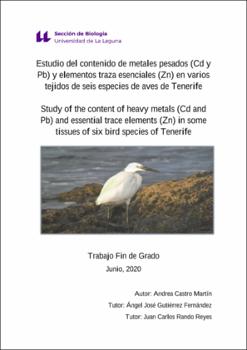Estudio del contenido de metales pesados (Cd y Pb) y elementos traza esenciales (Zn) en varios tejidos de seis especies de aves de Tenerife.
Autor
Castro Martín, AndreaFecha
2020Resumen
Se ha recopilado y analizado información sobre contenidos de cadmio (Cd), plomo (Pb) y zinc (Zn) en hígado, plumas y otras muestras biológicas de 6 especies de aves: pardela cenicienta (Calonectris borealis), garza real y garceta común (Ardea cinerea y Egretta garzetta), becada (Scolopax rusticola), gaviota patiamarilla (Larus michahellis)y búho chico (Asio otus canariensis).El objetivo es averiguar si el comportamiento trófico condiciona la acumulación de estos metales en sus tejidos internos. Los niveles de Cd y Pb tienden a ser menores en aves que se alimentan de invertebrados terrestres (S. rusticola) en comparación con rapaces (A. otus canariensis) y especies oportunistas (A.cinerea, E. garzettay L. michahellis). El Zn suele ser superior en pollos en crecimiento que en adultos. Sin embargo, factores fisiológicos, biológicoso ligados a las actividades humanas pueden influir en el proceso bioacumulativo de estos metales.En Canarias, se requieren estudios más profundos para conocer el impacto ecológico y el grado de exposición metálica al que se encuentra sometida la avifauna. Information about cadmium (Cd), lead (Pb) and zinc (Zn) content in liver, feathers and other bilogical samples has been collected and analyzed for 6 bird species: Cory’s shearwater (Calonectris borealis), grey heron and little egret (Ardea cinerea and Egretta garzetta) ,Eurasian woodcok (Scolopax rusticola), yellow-legged gull (Larus michahellis) and long-eared owl (Asio otus canariensis). The aim of this study is to assess if trophic behaviour can influence metallic accumulation in their inner tissues. Cd and Pb levels are usually lower in birds that feeds on soil invertebrates (S.rusticola) than raptors (A.otuscanariensis) and opportunistic species (A. cinerea, E. garzetta and L. michahellis).Zn can be higher in growing chicks compared to adults. However, physiological, biological factors or those related to human activities can modify the bioacumulation process of these metals. Further studies are needed in Canary islands to reveal the ecological impact and metallic exposure that affects bird species.





